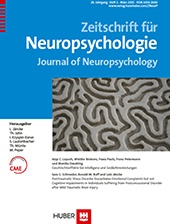Die Interpretation der intraindividuellen Variabilität bei psychischen Störungen oder psychiatrischer Komorbidität:
Ein Diskussionsbeitrag zum Beitrag von S. Bodenburg (ZfN), 25(2), 2014, 89 ff.
Abstract
Der Artikel „Standardabweichung und negative Antwortverzerrung” von Sebastian Bodenburg untersucht Möglichkeiten über die Standardabweichung von Reaktionszeiten einen eingebetteten Parameter zu bestimmen, der als objektives Maß für eine Erfassung negativer Antwortverzerrungen dienen soll. Diesen Ansatz halten wir für zukunftsträchtig, aus unserer Sicht wurden jedoch gerade in der Diskussion der Ergebnisse wesentliche frühere Befunde zu intraindividueller Variabilität nicht ausreichend gewürdigt. Insbesondere fehlt eine Einordnung der Ergebnisse mit Bezug auf psychiatrische Erkrankungen oder Komorbiditäten. Wir plädieren – auch und gerade vor dem Hintergrund der weitreichenden Implikationen der beschriebenen Befunde für die gutachterliche Einzelfallbeurteilung – für einen vorsichtigen Umgang mit den Ergebnissen im klinischen Alltag.
Literatur
(1994). Neurobehavioural performance of adults with closed-head injury, adults with attention deficit, and controls. Brain Injury, 8, 395 – 404.
(2003). Profile of neuropsychological deficits in older stroke survivors without dementia. Dementia and Geriatric Cognitive Disorders, 16, 53 – 56.
(2004). The functional neuroanatomical correlates of response variability: evidence from a response inhibition task. Neuropsychologia, 42, 1910 – 1916.
(2011). Default mode network connectivity predicts sustained attention deficits after traumatic brain injury. Journal of Neuroscience, 31, 13442 – 13451.
(2006). Sustained attention deficits in manic and euthymic patients with bipolar disorder. Progress in Neuropsychopharmacology Biological Psychiatry, 30, 1097 – 1102.
(2007). Intraindividual variability in neurocognitive speed: a comparison of Parkinsons disease and normal older adults. Neuropsychologia, 45, 2499 – 2507.
(2009). The utility of intraindividual variability in selective attention tasks as an early marker for Alzheimers disease. Neuropsychology, 23, 746 – 758.
(2014). Intraindividual variability in inhibitory function in adults with ADHD – An ex-Gaussian approach. PLOS ONE, 9, e112298.
(2008). Reaction times and performance variability in normal aging, mild cognitive impairment, and Alzheimers disease. Journal of Geriatric Psychiatry and Neurology, 21, 204 – 218.
(2002). Variability in reaction time performance of younger and older adults. The Jorunals of Gerontology Series B: Psychological Sciences and Social Sciences, 57, 101 – 115.
(2008). Intra-individual reaction time variability in schizophrenia, depression and borderline personality disorder. Brain and Cognition, 66, 73 – 83.
(2013). Reaction time variability in ADHD: a meta-analytic review of 319 studies. Clinical Psychology Review, 33, 795 – 811.
(2010). Intra-individual variability in high-functioning patients with schizophrenia. Psychiatry Research, 178, 27 – 32.
(1997). Attentional factors in response time variability after traumatic brain injury: an ERP study. Journal of the International Neuropsychological Society, 3, 95 – 107.
(2013). Increased response variability as a marker of executive dysfunction in veterans with post-traumatic stress disorder. Neuropsychologia, 51, 3033 – 3040.
(2012). Reaction time variability in ADHD: a review. Neurotherapeutics, 9, 500 – 508.
(2006). The neural bases of momentary lapses in attention. Nature Neuroscience, 9, 971 – 978.
(1995). Sustained arousal and attention after traumatic brain injury. Neuropsychologia, 33, 797 – 813.



